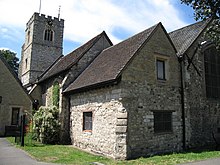Loading AI tools
Church in Barking and Dagenham, United Kingdom From Wikipedia, the free encyclopedia
St Margaret's Church or the Church of St Margaret of Antioch is a Church of England parish church in Barking, East London. The church is a Grade I listed building, on a site dating back to the 13th century, within the grounds of the Roman Catholic Barking Abbey, the ruins of a former royal monastery that was originally established in the 7th century. The building is dedicated to Margaret the Virgin, also known as Margaret of Antioch.
| St Margaret's Church, Barking | |
|---|---|
 | |
 | |
| 51°32′7.89″N 0°4′33.6504″E | |
| Location | Barking, Barking and Dagenham |
| Country | United Kingdom |
| Denomination | Church of England |
| Churchmanship | Anglo-Catholic & open evangelical |
| Website | Church website |
| History | |
| Status | Active |
| Dedication | Margaret the Virgin |
| Events | 1215: Foundation 1762: Marriage of Captain James Cook to Elizabeth Batts |
| Architecture | |
| Functional status | Parish church |
| Heritage designation | Grade I listed |
| Specifications | |
| Length | 134 feet (41 m)[1] |
| Width | 64 feet (20 m) |
| Height | 75 feet (23 m) |
| Bells | 8 |
| Tenor bell weight | 23 long cwt (2,600 lb or 1,200 kg) (heaviest) |
| Administration | |
| Province | Province of Canterbury |
| Diocese | Diocese of Chelmsford |
| Episcopal area | Barking Episcopal Area |
| Archdeaconry | Archdeaconry of Barking |
| Deanery | Barking |
| Parish | Barking |
| Clergy | |
| Rector | The Revd Mark Adams |
| NSM(s) | The Revd Elwon John |
| Laity | |
| Reader(s) | Canon Pat Nappin |
The church originated as a Roman Catholic chapel for local people within the grounds of Barking Abbey, to the south of the Abbey church. Its oldest part is the chancel, built early in the 13th century during the reign of King John. The building is said to have been made into a parish church in 1300 by Anne de Vere, abbess of the Abbey.[2] Until the 1390s Barking formed a rectory, held by the Abbey and divided into two vicarages known as 'Northstrete' (probably funded by income from the Ilford area) and 'Southstrete' (serving the Abbey church). The area suffered severe flooding in the late 14th century, leading to financial difficulties and a merger of the two vicarages from 1398 onwards.[3] A chaplain from the Abbey led worship.[4] The present bell tower was added late in the 15th century.
It remained a parish church when the Abbey was dissolved and the rectory and advowson devolved to the Crown, who initially leased it to the widow Mary Blackenhall for 21 years in 1540. In 1557 these were bought by Robert Thomas and Andrew Salter using money from the estate of William Pownsett of nearby Loxford, and granted to All Souls College, Oxford, in return for the vicar praying for the souls of Pownsett, his parents and benefactors every Sunday, giving 6 shillings and 8 pence amongst twenty poor people annually on the anniversary of Pownsett's death, paying the College an annual sum to maintain two poor scholars and only being absent from the parish 80 or fewer days a year. The College presented when the next vacancy occurred in 1560, but at the following one the Crown contested its right, though this was overturned via a lawsuit. Sir John Petre reconfirmed the 1557 grant in 1594, but dropped the requirement to pray for the dead. The right is now shared between All Souls College, Oxford, the Bishop of Chelmsford (in whose diocese it now falls) and the church's churchwardens.


The church contains several memorials, including one to the 17th-century politician Charles Montagu. The explorer Captain James Cook married Elizabeth Batts in the church on 21 December 1762.[5] Ten years later the nave, chancel and sanctuary all had their ceilings plastered, though this was removed from the nave ceiling in 1842.
Charles Winmill and George Jack were involved in a restoration of the interior between 1929 and 1936.[6][7] The building was Grade I listed in 1954.[8] An extension was added along the south side late in the 20th century to provide an office, bookshop and refectory.
In the late 1970s the parish became part of a team parish covering Barking with Christ Church and St Patrick's. On 1 January 2017, St Patrick's and Christchurch each gained their own parishes, taken from the team Parish area, leaving St Margaret's with a smaller Parish.
St Margaret's parish is unusual in having three churchwardens rather than two.[9]
In 2007, two small stones from remains of the old medieval London Bridge[10] were joined together in a sculpture in front of St Margaret's church facing the Barking Abbey ruins as part of several public artworks placed in Barking Town Centre by artist Joost Van Santen.[11]
The church is both Anglo-Catholic and open evangelical in tradition.[12]
Many vicars of Barking have gone on to become bishops. Hugh Jermyn was Bishop of Colombo 1871–1875, Bishop of Brechin 1875–1903 and Primus of Scotland 1886–1901. Robin Smith, a curate from 1962, was Bishop of Hertford 1990–2001.
Seamless Wikipedia browsing. On steroids.
Every time you click a link to Wikipedia, Wiktionary or Wikiquote in your browser's search results, it will show the modern Wikiwand interface.
Wikiwand extension is a five stars, simple, with minimum permission required to keep your browsing private, safe and transparent.